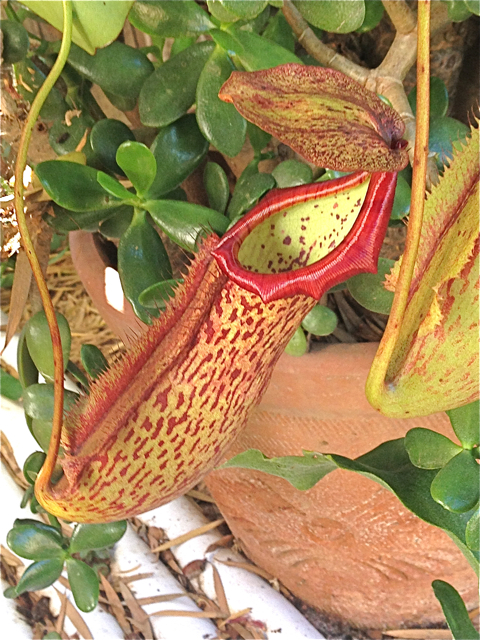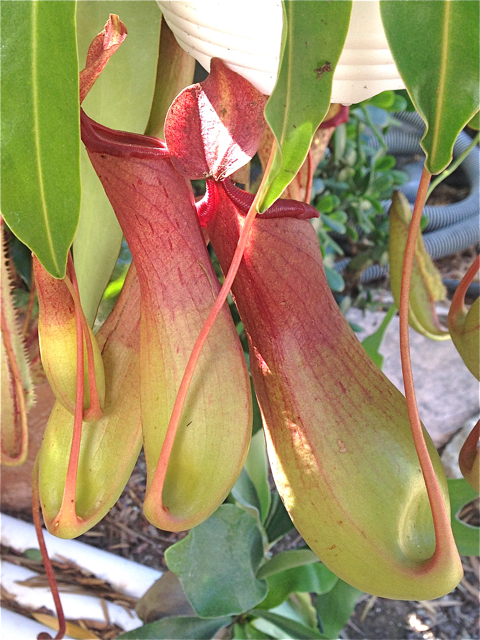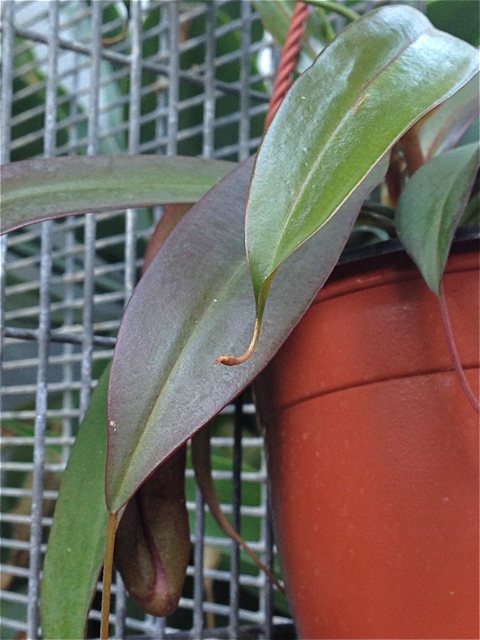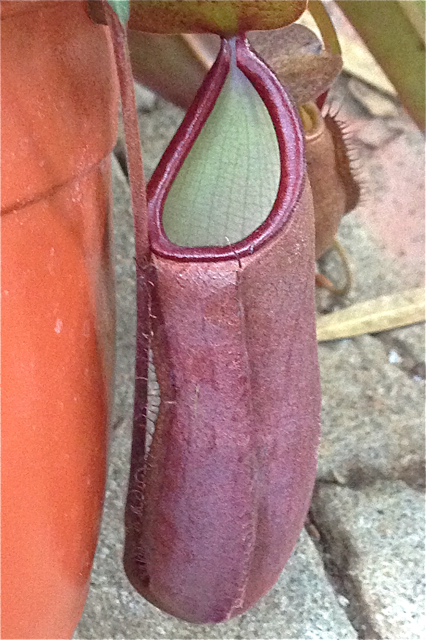Question Nepenthes #2
Nepenthes #2
 Nepenthes #1
Nepenthes #1
QUESTION: Dear Experts,
While in Home Depot, I came across 2 Nepenthes, which I couldn't resist purchasing. (This was my first experience with any carnivorous plants, and quite a "holy moly" moment.) On the label that came with either plant, there was some general care instructions, but no specific identification. They simply called the one plant, "Monkey Cups"; and the other plant, "Pitcher Plant".
I love my Nepenthes, and these 2 plants have been thriving for the past 7 months, despite making several learning mistakes. And it is because of this success and the fact that these plants are just so amazing, that I'd like to purchase and try growing some more species and/or hybrids. However, first, I need to find out what I have for several good reasons.
Attached are 2 photos of the pitchers from the 2 unidentified Nepenthes:
Size of the largest pitcher in the first photo is 6 inches (7 inches to upright lid). Pitchers in this plant are very plentiful, but variable in length between one and another. (I noticed that the smaller pitchers typically grow to the larger size, but not always and may be 1 to 2 inches smaller.) The leaves (partially pictured), are green, slender and currently up to 9 inches in length. Overall, this is the smaller of the 2 plants.
Size of the largest pitcher, which is the only pitcher pictured in the second photo, is around 10 inches to lid. Pitchers in that plant are all closer in size to each other, but there are fewer total pitchers. The leaves (not pictured), are green and quite wide with lengths currently up to 14 inches.
Can you identify these 2 Nepenthes?
Thank you,
Gretchen :-D
ANSWER: Hi Gretchen,
These are two common commercially produced varieties. The first one has been coined, "deRoose's alata (it's produced by deRoose Plants in Florida and The Netherlands). It's vigorous hybrid of Nepenthes alata x (N. alata x N. ventricosa).
The second plant is another one produced by deRoose and is called N. x Miranda. It another hybrid of N. maxima x N. northiana. It's another vigorous plants that likes lots of sun and gets very big. In good growing conditions 12" pitchers are very common.
I'm glad you've enjoyed our plants and DVD's. We really try hard to help folks be successful.
Good Growing!
Jeff Dallas
Sarracenia Northwest
http://www.growcarnivorousplants.com
---------- FOLLOW-UP ----------
 PHOTO #3-2
PHOTO #3-2
 PHOTO #3-1
PHOTO #3-1
QUESTION: WOW! I appreciate your thorough answer to my first question from the other day. THANK YOU! :-D
If you don't mind, I'd like to continue on this Nepenthes identification theme... I was a bad girl over the weekend and bought another Nepenthes from a local nursery. Again, the plant was not properly identified, and the nursery staff were not able to give further insight, since none were familiar enough with carnivorous plants.
Could you also identify what this little dark 'pitchered' Nepenthes beauty is? Pictures are attached.
DESCRIPTION:
The size of the largest pitcher in PHOTO #3-1, is only 3 inches (4 inches to its upright lid). The pitchers are a deep purple and the color is fairly uniform throughout the pitcher. The upper side of the lid is the same color as the pitcher body, but the interior of the pitcher is a light mint-green. (It's a striking contrast.) The wings on the pitcher are slightly textured or 'teethy'.
The leaves are pictured in the second photo - PHOTO #3-2. They are dark green with some tinted purple. Most are slender with the longest leaf currently up to 8 inches in length, but only 1.5 inches in width. Growth appears like it could be upright and vertical like the "deRoose's" alata, but I've had no growing experience with this plant, yet; and I believe I have purchased a young plant that may or may not represent what a mature plant would look like.
Thank you again for all your help. :-D
ANSWER: Hi Gretchen,
This looks like another plant mass produced by deRoose Plants. It's cultivar name is "Rebecca Soper", but you'll frequently see it marketed under the trade name "Alata Lantern" which I can never figure out since the plant is not a Nepenthes alata hybrid. It's Nepenthes gracillima x ventricosa. N. gracillima gives it the darker color. We've not grown this one in the nursery, but it's reported to be very easy and vigorous.
I wanted to give you a little warning too on Nepenthes identification. We've both been lucky in that the plants you've presented to me are very common, mass produced Nepenthes, so I know those plants well. There are literally thousands of different Nepenthes hybrids, and if the pedigree of a plant isn't know, ID is usually impossible. They just look too much alike. You can sometimes pick out particular features of more pronounced species such as N. truncata, N. ventricosa, N. albo-marginata in a hybrid, but way, way too many just look pretty generic. We have a whole bunch of hybrids we just call "Poi-Dogs", and many are very pretty, but we don't have the foggiest clue what their parentage is. Many commercially produced orchids such as Phalaenopsis are the same situation. There's lots of very pretty ones, but no one knows their pedigree.
Good Growing!
Jeff Dallas
Sarracenia Northwest
http://www.growcarnivorousplants.com
---------- FOLLOW-UP ----------
QUESTION: Thank you, again, Mr. Dallas! :-D
I've been looking through the photos of many of the carnivorous plants through a site called, "Carnivorous Plant Photofinder". This may not be the smartest way to go, since the pictures can be so variable even within a same species, but it is one of my starts, where I have no background and experience. And it seems - looking through these pictures, that not only the Nepenthes have a large array of hybrids with subtle and sometimes indistinguishable variations beyond their parentage, but it also appears the Sarracenia have a similar situation.
I'm glad you were able to recognize the 3 hybrids I presented, due to their common nature. This information gives me a baseline, which I think is important for a beginner. I do want to add to my collection of carnivorous plants, but I do want to purchase known hybrids and species more so initially, as well as I didn't want to initially repeat what I had already purchased. Later, I'm going to love the "Poi-Dogs" and the "Feist-Dogs"! Heck, I've already ventured on the 'dark side' and purchased a 'x "Hank"' from you, which is one PHENOMENALLY GORGEOUS Sarracenia... LOVE IT! :-D And I would imagine, that as my bog (Sarracenia in this case, I'm not sure if Nepenthes so freely and independently cross in hanging baskets???), develops over time that the cross-pollinated seeds will produce their own creations. I'll just try to be careful to preserve all identification on all known plants, particularly of any of the species plants important in this environmentally diminishing eco-system.
I'm looking forward to your 'Black Friday', as this disease keeps calling my name... LOL! Dare I venture to try a Cephalotus (oh my!) or two?... Naturally, only if offered for purchase from your company.
Thank you again,
Gretchen
AnswerHi Gretchen,
Thank-you for the kind words. We do try.
I use the cp photofinder often. It's run by Bob Ziemer of the ICPS, and he does a great job with it. It does show you the immense variability in a species or hybrids, but will give you a good baseline to know if a plant is really what you think it is. Here's some examples. I used it to confirm the ID of your Rebecca Soper. I had seen this plant in one of our local garden centers a couple years ago, and then found out it was being produced by deRoose. I also got a Sarracenia from a guy that got it directly from the Netherlands that turned out to be a Juthatip Soper, a very uncommon and beautiful hybrid in the US. CP photofinder is how I made that determination.
Bog gardens are lots of fun. You'll enjoy filling it. I'm glad you like Hank. It's a very cool plant.
Nepenthes hybrids are common in nature, and if you are someplace tropical like Hawaii hybrids form easy, but not so in homes or greenhouses. Nepenthes are Diecious, having male and female plants. You have to have one of each to get fertile seeds. Nepenthes flowers are also not all that pretty (compared to Sarracenia, which are stunning), and they stink. They have a chemical smell almost like bleach. Sarracenia are much easier to cross-pollinate.
Good Growing!
Jeff Dallas
Sarracenia Northwest
http://www.growcarnivorousplants.com









